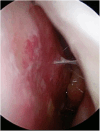Rhinologic Conditions of Pregnancy: A Retrospective Cohort Study
- PMID: 40291856
- PMCID: PMC12023001
- DOI: 10.1002/oto2.70114
Rhinologic Conditions of Pregnancy: A Retrospective Cohort Study
Abstract
Objective: To better understand the prevalence, risk factors, and management strategies of pregnancy-related rhinologic conditions.
Study design: Retrospective cohort study from January 2013 to January 2023.
Setting: Tertiary level Otolaryngology-Head and Neck Surgery clinic.
Methods: Pregnant patients with rhinologic concerns were included. Data were collected on various parameters including age during pregnancy, gestational age at evaluation for rhinologic complication, obstetric history, history of pregnancy loss, primigravida status, rhinologic condition, aspirin usage during pregnancy, and presence of advanced maternal age (AMA, ≥35 years old). Stata/SE 17.0 Software was used for statistical analysis. A P-value of <.05 was considered significant.
Results: Fifty-seven pregnant patients were included. Patients presented with epistaxis (N = 25, 43.9%), chronic rhinosinusitis exacerbations (N = 22, 38.6%), and rhinitis of pregnancy (N = 10, 17.5%). Mean age at presentation was 34.7 years (22-53). Multivariate analysis revealed associations between epistaxis and primigravida status (P = .008) and rhinitis of pregnancy with a history of pregnancy loss (P = .012). Gestational diabetes mellitus was significantly associated with epistaxis on univariate analysis (P = .011).
Conclusion: There is a need for increased awareness among health care providers, including otolaryngologists, regarding the diagnosis and management of rhinologic conditions of pregnancy.
Keywords: advanced maternal age (AMA); chronic rhinosinusitis; epistaxis; otolaryngology; primigravida; rhinitis of pregnancy; rhinologic conditions of pregnancy.
© 2025 The Author(s). OTO Open published by Wiley Periodicals LLC on behalf of American Academy of Otolaryngology‐Head and Neck Surgery Foundation.
Conflict of interest statement
None.
Figures


Similar articles
-
Sinuses and Common Rhinologic Conditions.Med Clin North Am. 2018 Nov;102(6):993-1000. doi: 10.1016/j.mcna.2018.06.003. Epub 2018 Aug 18. Med Clin North Am. 2018. PMID: 30342616 Free PMC article. Review.
-
Rhinologic issues in pregnancy.Allergy Rhinol (Providence). 2012;3(1):e13-5. doi: 10.2500/ar.2012.3.0028. Epub 2012 Jun 21. Allergy Rhinol (Providence). 2012. PMID: 22852124 Free PMC article.
-
Rhinologic outcome of endoscopic transnasal-transsphenoidal pituitary surgery: an institutional series, systematic review, and meta-analysis.Eur Arch Otorhinolaryngol. 2023 Sep;280(9):4091-4099. doi: 10.1007/s00405-023-07934-w. Epub 2023 Mar 29. Eur Arch Otorhinolaryngol. 2023. PMID: 36988686 Free PMC article.
-
Different rhinologic diseases cause a similar multidimensional decrease in generic health-related quality of life.Clin Otolaryngol. 2018 Dec;43(6):1487-1493. doi: 10.1111/coa.13190. Epub 2018 Sep 2. Clin Otolaryngol. 2018. PMID: 29992752
-
Computed tomography imaging practice patterns in adult chronic rhinosinusitis: survey of the American Academy of Otolaryngology-Head and Neck Surgery and American Rhinologic Society membership.Int Forum Allergy Rhinol. 2015 Jun;5(6):506-12. doi: 10.1002/alr.21483. Epub 2015 Apr 23. Int Forum Allergy Rhinol. 2015. PMID: 25907412
Cited by
-
Pregnancy Rhinitis: Pathophysiological Mechanisms, Diagnostic Challenges, and Management Strategies-A Narrative Review.Life (Basel). 2025 Jul 23;15(8):1166. doi: 10.3390/life15081166. Life (Basel). 2025. PMID: 40868814 Free PMC article. Review.
References
LinkOut - more resources
Full Text Sources

